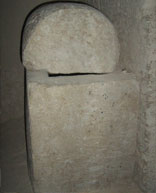In Jewish Sites
The Madras Ruins
The Madras Ruins, or Churvat Madras as they are called in Hebrew, refer to the remnants of an ancient agriculture settlement in the Judea region. The Madras Ruins are considered to be one of the largest sites in the region that have survived from the days of the Second Temple, the Mishna and the Talmud.
The name of the site
The Arabic name for the site is 'Charvat Drussia', while the Romans called it 'Drusis'. Some are of the opinion that the infamous thief 'Ben Drosai' was actually a resident of Madras.
The city is located on a low hill beside a central main road that controls all the pathways to the mountains of Jerusalem and Hebron, the Elleh Valley and the south of the country.
The history of the site and its structures:
The city was apparently established during the Hellenistic period, 200 B.C.E.
The era is known for its 'Columbarium caves', which look like many holes etched out in the rocks.
The site additionally features many wells and underground chambers.
Pictured: the Columbarium caves
Jews settled in the city during the period of the Second Temple and continued to reside there following the destruction of the Temple as well.
Research indicates that the complicated underground tunnel systems which were discovered at the site were created at the time of the Bar Kochba Revolt.
The underground tunnel systems are based on numerous chambers that are connected by tunnels.
The tunnel systems served the fighters as underground shelters in times of danger. The very complex system also holds several storage rooms for food, oil and water.
The assumption that the underground tunnel system was created during the time of the Bar Kochba Revolt is primarily based on the writings of the Greek historian Lucius Cassius Dio Cocceianus, who testifies: "When Caesar Traianus Hadrianus Augustus moved further away, they (the Jews) fought the Romans openly; however they did not dare fight the Romans in open battle, but they etched out tunnels in the rocks so that they may have shelters in times of need and also for them to secretly assemble underground. They dug pits in the ground in various places so that air and light would penetrate." The city was destroyed during the Bar Kochba Revolt and was left deserted.
Approximately three hundred years thereafter, during the Byzantine Period, a small Christian community settled in the ruins of the city. The community ceased to exist one century later. The remnants of that community demonstrate that it had been substantially smaller than the Jewish community which had lived in the city during the Second Temple era.
The Byzantine Sepulcher, which is located at the site, is also believed to belong to the same era. The Sepulcher is a magnificent grave dug in a rock, which can be accessed through a square-shaped external yard. The door to the entrance is a round stone that moves on a track and protects the grave. Inside, two burial plots can be found. The burial process was divided into two stages: during the first stage, the body was laid in the grave, and during the second stage – which took place a few months later when the body had already decomposed and only the bones remained – the bones were removed from the grave and placed in a small sarcophagus. The size of the sarcophagus is similar to that of the thigh bone (femur), the longest bone in the human body.
 |
|
| Entrance Sign | צלם |
 |
|
| צלם | |
 |
|
| Flowers | צלם |
 |
|
| Entrance to the Burial Cave | צלם |
 |
|
| Robbery Breach of Grave Sites | צלם |
 |
|
| Mandrakes in the Ruins | צלם |







